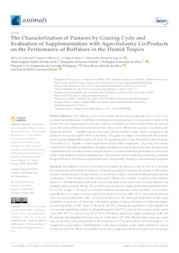The characterization of pastures by grazing cycle and evaluation of supplementation with agro-industry co-products on the performance of buffaloes in the humid tropics.
The characterization of pastures by grazing cycle and evaluation of supplementation with agro-industry co-products on the performance of buffaloes in the humid tropics.
Author(s): OLIVEIRA, K. C. C. DE; FATURI, C.; GARCIA, A. R.; JOELE, M. R. S. P.; NAHUM, B. de S.; SILVA, W. C. DA; RODRIGUES, T. C. G. DE C.; SILVA, E. B. R. DA; LOURENÇO JÚNIOR, J. DE B.
Summary: The objective was to characterize the pastures by grazing cycle, as well as to evaluate the performance of buffaloes in intensive rotational grazing in a silvopastoral system in the eastern Amazon supplemented with agro-industry co-products in order to characterize the grazing cycles, the composition of the fractions, and the carcass yield. Fifteen non-castrated, crossbred water buffaloes (Murrah × Mediterranean) were used. All animals used in the study were clinically healthy and weighed approximately 458 kg. The animals were grazed in a single group, and supplementation (1% of live weight—LW/day) was divided into three treatments: control (control—conventional ingredients); Cocos nucifera coconut cake (Cocos nucifera) (coconut cake—70%); and palm kernel cake (Guinean elaeis) (palm kernel cake—70% palm kernel cake). The chemical composition of the forage is different in each part of the plant, with higher protein values in the leaves (11.40%) and higher acid detergent fiber (ADF) values in the stems (50.03%). Among the ingredients of the supplement, corn has the highest percentage of indigestible protein (35.57%), most of the protein in palm kernel cake is B3 (49.11%), and in Coco, B2 (51.52%). Mombasa grass has a higher percentage of B3 and B2 proteins; the indigestible fraction is lower in the leaves (17.16%). The leaf/stem ratio also varied between grazing cycles, being better in the second cycle (2.11%) and with an overall average of 1.71. Supplement consumption varied between cycles and was higher in the control treatment, with an overall mean of 4.74. There was no difference in daily weight gain and carcass yield, with an average of 1 kg/day and 49.23%, respectively. Therefore, it can be concluded that including supplements based on by-products from the coconut and palm oil agro-industries promotes performance and carcass yields compatible with conventional supplements. Their use reduces production costs, optimizes the utilization of forage mass, enhances the sustainability of the production chain, and, therefore, is recommended.
Publication year: 2024
Types of publication: Journal article
Observation
Some of Embrapa's publications are published as ePub files. To read them, use or download one of the following free software options to your computer or mobile device. Android: Google Play Books; IOS: iBooks; Windows and Linux: Calibre.
Access other publications
Access the Agricultural Research Database (BDPA) to consult Embrapa's full library collection and records.
Visit Embrapa Bookstore to purchase books and other publications sold by Embrapa.

